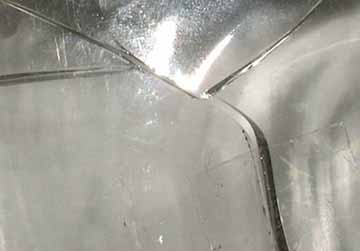GLASS BOTTLE FAILURE FROM INTERNAL PRESSURE
by
Charles C. Roberts, Jr.
Glass fails in a brittle manner at nominal ambient temperatures
with little stretching or elongation prior to failure. Crack
propagation is influenced by many factors, including stress
distribution and structural shape. The following is a study in failure
analysis of an ordinary milk bottle. Figure 1 is a view of the initial
condition of the artifact.

Figure 1
A first step is to attempt to delicately reassemble the bottle to
observe distinguishing fracture patterns. Clear tape is a useful tool
in holding the bottle in position. Start with major pieces and
carefully tape together the fragments. The result is shown in
Figures 2 and 3. A piece of white paper is placed inside the bottle
as it is reconstructed so that the fracture can be analyzed without
optical interference from the other side. Figure 2 is a view of one
side of the bottle


Figure 2 Figure 3
showing far less fragmentation of the glass than that shown in
Figure 3. Typically, the fracture origin is at an area of high stress
and high energy release. This results in branching of the fracture in
many directions. Figure 4 is a view of

Figure 4
the fracture origin near the middle of the long side of the bottle.
This fracture pattern is typical of pressure inside the bottle. The
pressure induces bending stresses near the middle of one of the
large sides of the bottle. Once the fracture initiates, it branches
quickly into the double Y pattern shown in Figure 4. When the
pressure is relieved, there is usually less damage to the opposite
large side of the bottle, as was evident in Figure 2. The fracture of
the bottle in Figures 1 through 4 was a result of a test where a glass
bottle, full of water, was placed in a freezer. After the water froze,
expansion caused the internal pressure related fracture pattern.
Fractures of milk bottles are often blamed on manufacturing
defects. However, investigation of the means of storage of full
milk bottles may yield information showing the bottle to have been
improperly stored in a freezing environment. The classical double
Y fracture shown in Figure 4 is a significant indicator of such
misuse.
FOR TECHNICAL ARTICLES CONTACT CLAIMS MAGAZINE AND ASK
FOR A REPRINT OF A PAST TECHNICAL NOTEBOOK ARTICLE
CLAIMS MAGAZINE




